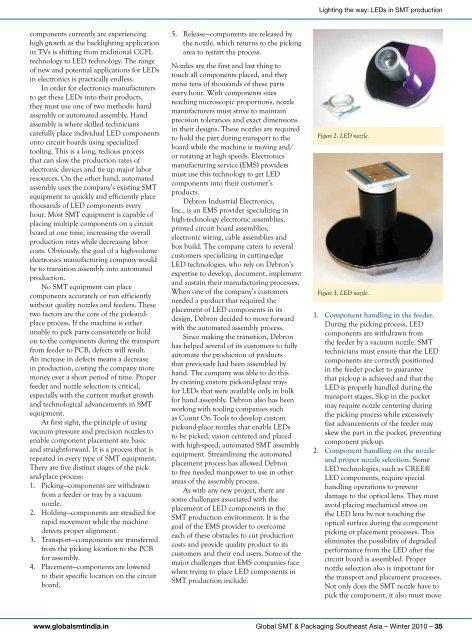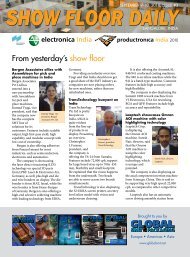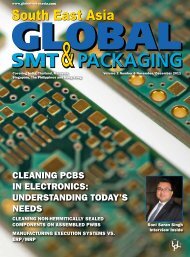South East Asia - WordPress.com - BluOcean.AdMedia
South East Asia - WordPress.com - BluOcean.AdMedia
South East Asia - WordPress.com - BluOcean.AdMedia
Create successful ePaper yourself
Turn your PDF publications into a flip-book with our unique Google optimized e-Paper software.
<strong>com</strong>ponents currently are experiencing<br />
high growth as the backlighting application<br />
in TVs is shifting from traditional CCFL<br />
technology to LED technology. The range<br />
of new and potential applications for LEDs<br />
in electronics is practically endless.<br />
In order for electronics manufacturers<br />
to get these LEDs into their products,<br />
they must use one of two methods: hand<br />
assembly or automated assembly. Hand<br />
assembly is where skilled technicians<br />
carefully place individual LED <strong>com</strong>ponents<br />
onto circuit boards using specialized<br />
tooling. This is a long, tedious process<br />
that can slow the production rates of<br />
electronic devices and tie up major labor<br />
resources. On the other hand, automated<br />
assembly uses the <strong>com</strong>pany’s existing SMT<br />
equipment to quickly and efficiently place<br />
thousands of LED <strong>com</strong>ponents every<br />
hour. Most SMT equipment is capable of<br />
placing multiple <strong>com</strong>ponents on a circuit<br />
board at one time, increasing the overall<br />
production rates while decreasing labor<br />
costs. Obviously, the goal of a high-volume<br />
electronics manufacturing <strong>com</strong>pany would<br />
be to transition assembly into automated<br />
production.<br />
No SMT equipment can place<br />
<strong>com</strong>ponents accurately or run efficiently<br />
without quality nozzles and feeders. These<br />
two factors are the core of the pick-andplace<br />
process. If the machine is either<br />
unable to pick parts consistently or hold<br />
on to the <strong>com</strong>ponents during the transport<br />
from feeder to PCB, defects will result.<br />
An increase in defects means a decrease<br />
in production, costing the <strong>com</strong>pany more<br />
money over a short period of time. Proper<br />
feeder and nozzle selection is critical,<br />
especially with the current market growth<br />
and technological advancements in SMT<br />
equipment.<br />
At first sight, the principle of using<br />
vacuum pressure and precision nozzles to<br />
enable <strong>com</strong>ponent placement are basic<br />
and straightforward. It is a process that is<br />
repeated in every type of SMT equipment.<br />
There are five distinct stages of the pickand-place<br />
process:<br />
1. Picking—<strong>com</strong>ponents are withdrawn<br />
from a feeder or tray by a vacuum<br />
nozzle.<br />
2. Holding—<strong>com</strong>ponents are steadied for<br />
rapid movement while the machine<br />
detects proper alignment.<br />
3. Transport—<strong>com</strong>ponents are transferred<br />
from the picking location to the PCB<br />
for assembly.<br />
4. Placement—<strong>com</strong>ponents are lowered<br />
to their specific location on the circuit<br />
board.<br />
www.globalsmtindia.in<br />
5. Release—<strong>com</strong>ponents are released by<br />
the nozzle, which returns to the picking<br />
area to restart the process.<br />
Nozzles are the first and last thing to<br />
touch all <strong>com</strong>ponents placed, and they<br />
move tens of thousands of these parts<br />
every hour. With <strong>com</strong>ponents sizes<br />
reaching microscopic proportions, nozzle<br />
manufacturers must strive to maintain<br />
precision tolerances and exact dimensions<br />
in their designs. These nozzles are required<br />
to hold the part during transport to the<br />
board while the machine is moving and/<br />
or rotating at high speeds. Electronics<br />
manufacturing service (EMS) providers<br />
must use this technology to get LED<br />
<strong>com</strong>ponents into their customer’s<br />
products.<br />
Debron Industrial Electronics,<br />
Inc., is an EMS provider specializing in<br />
high-technology electronic assemblies,<br />
printed circuit board assemblies,<br />
electronic wiring, cable assemblies and<br />
box build. The <strong>com</strong>pany caters to several<br />
customers specializing in cutting-edge<br />
LED technologies, who rely on Debron’s<br />
expertise to develop, document, implement<br />
and sustain their manufacturing processes.<br />
When one of the <strong>com</strong>pany’s customers<br />
needed a product that required the<br />
placement of LED <strong>com</strong>ponents in its<br />
design, Debron decided to move forward<br />
with the automated assembly process.<br />
Since making the transition, Debron<br />
has helped several of its customers to fully<br />
automate the production of products<br />
that previously had been assembled by<br />
hand. The <strong>com</strong>pany was able to do this<br />
by creating custom pick-and-place trays<br />
for LEDs that were available only in bulk<br />
for hand assembly. Debron also has been<br />
working with tooling <strong>com</strong>panies such<br />
as Count On Tools to develop custom<br />
pick-and-place nozzles that enable LEDs<br />
to be picked, vision centered and placed<br />
with high-speed, automated SMT assembly<br />
equipment. Streamlining the automated<br />
placement process has allowed Debron<br />
to free needed manpower to use in other<br />
areas of the assembly process.<br />
As with any new project, there are<br />
some challenges associated with the<br />
placement of LED <strong>com</strong>ponents in the<br />
SMT production environment. It is the<br />
goal of the EMS provider to over<strong>com</strong>e<br />
each of these obstacles to cut production<br />
costs and provide quality product to its<br />
customers and their end users. Some of the<br />
major challenges that EMS <strong>com</strong>panies face<br />
when trying to place LED <strong>com</strong>ponents in<br />
SMT production include:<br />
Lighting the way: LEDs in SMT production<br />
Figure 2. LED nozzle.<br />
Figure 3. LED nozzle.<br />
1. Component handling in the feeder.<br />
During the picking process, LED<br />
<strong>com</strong>ponents are withdrawn from<br />
the feeder by a vacuum nozzle. SMT<br />
technicians must ensure that the LED<br />
<strong>com</strong>ponents are correctly positioned<br />
in the feeder pocket to guarantee<br />
that pick-up is achieved and that the<br />
LED is properly handled during the<br />
transport stages. Slop in the pocket<br />
may require nozzle centering during<br />
the picking process while excessively<br />
fast advancements of the feeder may<br />
skew the part in the pocket, preventing<br />
<strong>com</strong>ponent pick-up.<br />
2. Component handling on the nozzle<br />
and proper nozzle selection. Some<br />
LED technologies, such as CREE®<br />
LED <strong>com</strong>ponents, require special<br />
handling operations to prevent<br />
damage to the optical lens. They must<br />
avoid placing mechanical stress on<br />
the LED lens by not touching the<br />
optical surface during the <strong>com</strong>ponent<br />
picking or placement processes. This<br />
eliminates the possibility of degraded<br />
performance from the LED after the<br />
circuit board is assembled. Proper<br />
nozzle selection also is important for<br />
the transport and placement processes.<br />
Not only does the SMT nozzle have to<br />
pick the <strong>com</strong>ponent, it also must move<br />
Global SMT & Packaging <strong>South</strong>east <strong>Asia</strong> – Winter 2010 – 35









